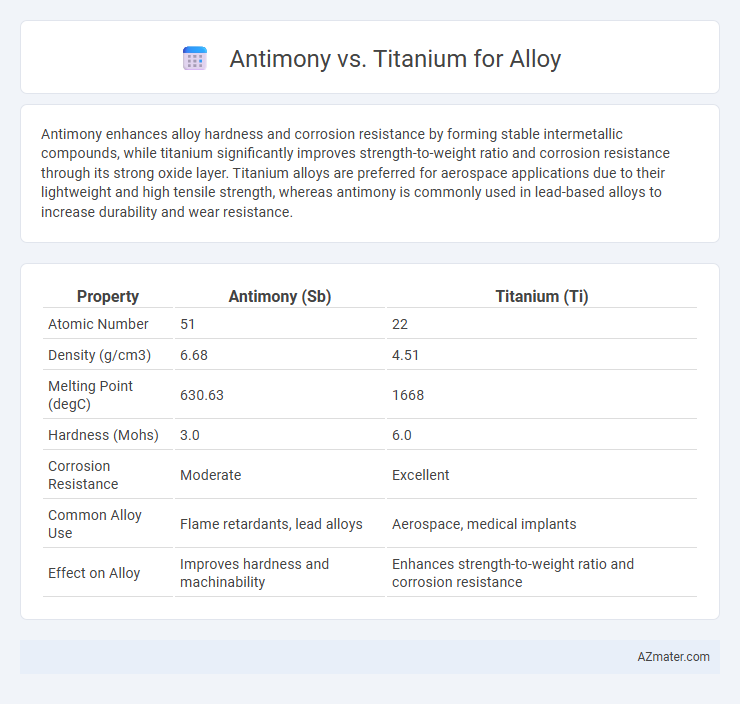Antimony enhances alloy hardness and corrosion resistance by forming stable intermetallic compounds, while titanium significantly improves strength-to-weight ratio and corrosion resistance through its strong oxide layer. Titanium alloys are preferred for aerospace applications due to their lightweight and high tensile strength, whereas antimony is commonly used in lead-based alloys to increase durability and wear resistance.
Table of Comparison
| Property | Antimony (Sb) | Titanium (Ti) |
|---|---|---|
| Atomic Number | 51 | 22 |
| Density (g/cm3) | 6.68 | 4.51 |
| Melting Point (degC) | 630.63 | 1668 |
| Hardness (Mohs) | 3.0 | 6.0 |
| Corrosion Resistance | Moderate | Excellent |
| Common Alloy Use | Flame retardants, lead alloys | Aerospace, medical implants |
| Effect on Alloy | Improves hardness and machinability | Enhances strength-to-weight ratio and corrosion resistance |
Introduction to Antimony and Titanium in Alloys
Antimony is primarily used in alloys to enhance hardness and strength, often incorporated in lead alloys for batteries and bearings. Titanium, renowned for its high strength-to-weight ratio and corrosion resistance, is widely used in aerospace and medical alloys. Combining these elements in alloys results in materials that balance durability and lightweight properties, optimizing performance in demanding applications.
Chemical and Physical Properties Comparison
Antimony, a metalloid with atomic number 51 and a density of 6.68 g/cm3, is primarily used as an alloying element to increase hardness and mechanical strength in lead and tin-based alloys, due to its moderate melting point of 630.6 degC and low thermal and electrical conductivity. Titanium, a transition metal with atomic number 22 and a lower density of 4.51 g/cm3, exhibits exceptional corrosion resistance, high tensile strength, and a melting point of 1668 degC, making it ideal for lightweight, high-strength alloys in aerospace and biomedical applications. The chemical inertness of titanium contrasts with the more reactive antimony, influencing alloy selection based on required durability, weight, and environmental resistance.
Common Applications in Industry
Antimony is commonly used in alloys to enhance hardness and strength, particularly in lead-based applications such as battery grids, ammunition, and type metal for printing. Titanium alloys are highly valued in aerospace, medical implants, and automotive industries due to their exceptional strength-to-weight ratio, corrosion resistance, and biocompatibility. While antimony-containing alloys are often chosen for electrical and casting purposes, titanium alloys dominate structural and high-performance applications requiring durability and lightweight properties.
Strength and Durability Differences
Titanium alloys exhibit superior strength-to-weight ratios compared to antimony-infused alloys, making them ideal for aerospace and automotive applications requiring high durability under stress. Antimony primarily enhances hardness and wear resistance when alloyed with metals like lead or tin but does not significantly improve tensile strength or fracture toughness. Titanium alloys maintain corrosion resistance and fatigue strength in extreme environments, outperforming antimony-based materials in long-term structural integrity.
Corrosion Resistance: Antimony vs Titanium
Titanium exhibits superior corrosion resistance compared to antimony, making it highly suitable for alloys in harsh chemical and marine environments. Antimony, while used primarily as an alloying element to enhance hardness and strength in metals like lead, offers limited resistance to corrosion on its own. Titanium alloys form a stable oxide layer that prevents oxidation and degradation, significantly outperforming antimony in long-term durability under corrosive conditions.
Alloying Techniques and Compatibility
Antimony enhances alloys primarily by improving hardness and wear resistance through solid solution strengthening, commonly alloyed with lead, tin, or copper using melting and casting techniques that ensure uniform distribution. Titanium, favored for its strength-to-weight ratio and corrosion resistance, is alloyed with aluminum, vanadium, or iron via advanced methods such as powder metallurgy or vacuum arc remelting to maintain purity and optimize mechanical properties. Compatibility challenges arise due to differing melting points--antimony melts at 630.6degC versus titanium's 1668degC--necessitating careful control of processing temperatures and atmosphere to prevent phase separation or contamination in multi-component alloys.
Environmental and Health Considerations
Antimony, often used as a flame retardant in alloys, poses significant environmental concerns due to its toxicity and persistence, potentially contaminating soil and water. Titanium alloys are favored for their biocompatibility and corrosion resistance, making them safer for medical and aerospace applications with minimal ecological impact. The production and disposal of antimony-containing alloys require stringent controls to mitigate health risks, whereas titanium alloys typically exhibit lower environmental toxicity throughout their lifecycle.
Cost and Availability Factors
Antimony is significantly less expensive than titanium due to its abundant supply as a byproduct of mining other metals, making it readily available for alloy production. Titanium, prized for its superior strength-to-weight ratio and corrosion resistance, commands a higher price largely because of complex extraction and processing methods from titanium ores like rutile and ilmenite. The cost-effectiveness of antimony alloys suits applications requiring enhanced hardness and flame retardancy, whereas titanium alloys dominate in high-performance sectors despite higher material costs and limited raw material availability.
Performance in Extreme Conditions
Antimony alloys enhance hardness and corrosion resistance, making them ideal for use in extreme temperatures and chemically aggressive environments. Titanium alloys provide superior strength-to-weight ratio and exceptional resistance to high temperatures and corrosion, especially in aerospace and marine applications. Compared to antimony, titanium alloys offer better performance under mechanical stress and thermal cycling, ensuring durability and reliability in the harshest conditions.
Choosing the Right Alloy for Your Needs
Choosing between antimony and titanium alloys depends on the application requirements such as strength, corrosion resistance, and weight. Titanium alloys offer superior strength-to-weight ratios and excellent corrosion resistance, ideal for aerospace and medical applications. Antimony, often used as an alloying element in lead or tin, enhances hardness and durability in batteries and flame retardants but is less suitable for structural purposes.

Infographic: Antimony vs Titanium for Alloy
 azmater.com
azmater.com